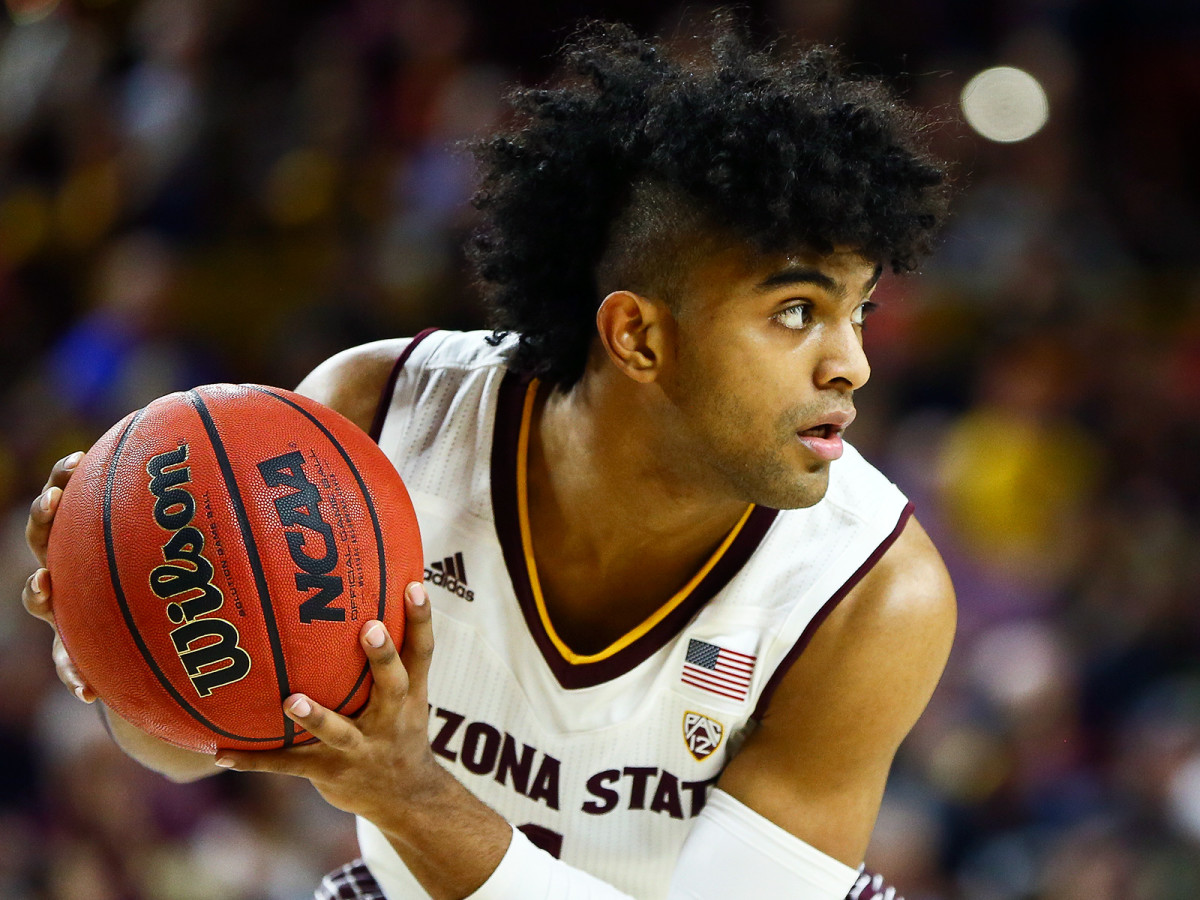Expect the Unexpected in a Wide-Open Pac-12 Tournament

The Pac-12 has its faults, but having Las Vegas host its conference tournament is not one of them. It was an interesting regular season for the league to say the least, as the Conference of Champions turned into the Conference of Cannibalism, with teams out of the at-large picture consistently delivering blows to ones on the bubble. Now, there are several teams that need at least one tournament win to hear their names called on Selection Sunday.
Here is everything you need to know before Wednesday’s tip-off.
Why You Should Watch: Unpredictability
If you’re looking for a tournament that can deliver utter chaos, look no further. There isn’t a dominant team in the Pac-12 this season, and the result is a wide-open field. In fact, all four opening-round matchups pit two teams that split their season series.
The Pac-12 tournament has been extremely chalky since moving to Las Vegas in 2013, with the championship game pitting the No. 1 and No. 2 seeds against each other four out of five years. The one exception was No. 3 Oregon upsetting No. 1 UCLA in ’13.
Bank on a few upsets happening this time around. Arizona was the Pac-12 regular-season champion, but the Wildcats have their worst-ranked defense (95th in KenPom adjusted defensive efficiency) since Sean Miller’s first season in Tucson. No. 2 seed USC’s best win so far this season came against Middle Tennessee on a neutral floor, and the Trojans have struggled to hold on to big leads thanks to inexplicably long cold stretches on the offensive end. Arizona has also been allergic to double-digit leads, blowing them in nine of 18 games in conference play (although the Wildcats do hold an 8–1 record in those games). Simply put, a Pac-12 game is never over until it’s over.
The Pac-12 tournament’s watchability is also helped by the fact that the favorite to be the No. 1 overall pick in the upcoming NBA draft will be playing at T-Mobile Arena.
Best Player: Deandre Ayton
If there was one word to describe Arizona’s freshman behemoth, it would be “unfair.” He combines unbelievable physical tools with a jaw-dropping skill set for a seven-footer. Ayton has looked and played like a man among boys for the entire season, averaging a double double (19.9 points and 11.4 rebounds) on 61.6% shooting from the floor. On the defensive end, he’s averaging more than two blocks a game in conference play.
The numbers reaffirm Ayton is a matchup nightmare for opponents. According to data compiled from Synergy Sports Technology, he recorded 1.177 points per possession in the half-court, which placed him in the 98th percentile among all players.
There is no player in the Pac-12, and possibly the country, who can handle him. But there have been stretches in games this season where Arizona somehow seemingly forgets that Ayton is on the floor. When the Wildcats do feed him the ball early and often, though, they are the most efficient offense in the conference.
Best Player You Probably Haven’t Heard Of: Justin Bibbins
Utah is a surprising No. 3 seed, and its 5'8" graduate transfer point guard played an integral role in the team exceeding expectations. After playing his first three seasons at Long Beach State, Bibbins had no problem transitioning from the Big West to the Pac-12. In conference play, he finished in the top 10 in points, assists, assist-to-turnover ratio, steals, free-throw percentage, three-point percentage and minutes played.
Bibbins can burn opposing guards in multiple ways on offense. In particular, he is lethal as Utah’s pick-and-roll ballhandler (posting a PPP mark in the 92nd percentile per Synergy) and as a spot-up shooter (98th percentile). He’s also unafraid to take over when his team needs it most, hitting several big shots for Utah in crunch time. He’s even received the highest of praise from Bill Walton, as the Hall of Famer compared him to Michael Jordan and John Mayer in the same sentence.
In a conference filled with point guards who can put their teams on their backs such as UCLA’s Aaron Holiday and USC’s Jordan McLaughlin, the Utes will go as far as Bibbins takes them.
Bubble Teams With Most to Gain: Arizona State, UCLA, USC, Utah, Washington
Arizona is the only Pac-12 team that wouldn’t have to sweat Selection Sunday if it doesn’t pick up a win in Vegas.
Arizona State started off scorching and has two huge wins on its résumé (at Kansas and on a neutral court vs. Xavier), but slumped its way to an 8–10 record in conference play. UCLA also has two great wins away from home (Arizona and Kentucky) and a season sweep over crosstown rival USC, but it has been plagued by inconsistency and a shoddy defense. However, if the Sun Devils and Bruins each notch one Pac-12 tournament win, they should end up in the field.
It gets trickier with the other teams. USC has more Quadrant 1 wins, a higher RPI and KenPom rating, and a better conference finish than Utah and Washington. All three teams need to pick up multiple Ws at T-Mobile Arena to at least have a shot of making it into the field, but it may not be enough if bid stealers arise in other conference tournaments.
Sleeper Team: Oregon
The Ducks lost a ton of talent from last year’s Final Four run, and it took a while for their new pieces to jell. Oregon coach Dana Altman is a master of switching between man and zone defense, and his overall defensive scheme can definitely be difficult to grasp at first for newcomers.
Outside of a stunning loss at Washington State (an Ernie Kent revenge game!), Oregon has been playing its best basketball of late, including a sweep of Arizona and Arizona State in Eugene. Oregon’s length can really frustrate the opposition, particularly Paul White and Kenny Wooten, the Pac-12’s leader in blocks.
The top reason behind the Oregon sleeper pick is its draw. The No. 6-seeded Ducks are on the easier side of the bracket, as the toughest teams they’d face in the quarters and semis would be No. 3 Utah and No. 2 USC rather than No. 4 UCLA and No. 1 Arizona.
Oregon also has a big advantage in close games: It is the best free-throw shooting team in the Pac-12, and the 13th-best in the country. Add in other ingredients such as the best coach in the conference and a steady floor general in Payton Pritchard, and the Ducks certainly have a puncher’s chance to steal a bid.
Best Hair: Remy Martin

Arizona State’s freshman has an electric game and he’s the co-winner of the Pac-12’s Sixth Man of the Year award. While his play jumps off the screen because of his relentless energy, it’s easy to get lost staring at his majestic hair. I’d describe it as 50% The Weeknd and 50% Sideshow Bob.
Best Name: UCLA’s Prince Ali
Make way for Prince Ali, say hey it’s Prince Ali! Hot take alert: Aladdin is an undisputable top-three Disney movie.
Best Place to Eat Near T-Mobile Arena: Bruxie
T-Mobile Arena does have options, including a Shake Shack. There’s no need to settle, though, if you’re looking for better quality nearby. Bruxie started as a Southern California establishment, but has expanded to Korea and Vegas. Waffles are the name of the game at Bruxie, and culinary delights ranging from fried chicken to roasted mushrooms and goat cheese are sandwiched in between the waffles. Besides the tasty sandwich options, Bruxie also offers very solid waffle fries. Time is a factor if you’re looking to grab a bite outside the arena, and Bruxie aces that aspect as well.
Best Feud: Tad Boyle vs. Andy Enfield, Tad Boyle vs. Sean Miller (tie)
Colorado coach Tad Boyle wasn’t afraid to speak his mind about Arizona’s role in the FBI’s probe into college basketball. When asked if beating Arizona was extra satisfying because of the Wildcats’ involvement in the scandal, he unequivocally responded “Absolutely.” Boyle also mentioned USC’s recruiting success in the same press conference. Enfield exacted revenge by calling a timeout against Colorado with 21 seconds remaining ... and his team up 12 points. Will there be any additional fireworks on the sidelines in Vegas from this no-love-lost triangle?
The Picks
First round: No. 5 Stanford over No. 12 Cal, No. 6 Oregon over No. 11 Washington State, No. 10 Oregon State over No. 7 Washington, No. 9 Arizona State over No. 8 Colorado
Quarterfinals: No. 1 Arizona over No. 9 Arizona State, No. 2 USC over No. 10 Oregon State, No. 6 Oregon over No. 3 Utah, No. 4 UCLA over No. 5 Stanford
Semifinals: No. 4 UCLA over No. 1 Arizona, No. 6 Oregon over No. 2 USC
Final: No. 4 UCLA over No. 6 Oregon
Why UCLA Will Win
UCLA posed the biggest threat to Arizona during the regular season because the Wildcats couldn’t figure out how to counter the Bruins’ tempo. Arizona’s transition defense was a weak point this season, as it allowed 1.103 points per possession in that department, which placed it in the 11th percentile of all 351 Division-I teams. Arizona has struggled with dribble penetration, and there is no guard in the Pac-12 that will take advantage of that more than Aaron Holiday. And while I mentioned earlier that it’s nearly impossible to stop Ayton, UCLA’s post defense has been sneaky good thanks to its length. Per Synergy, Ayton has posted up defenders on 29.3% of possessions, and the Bruins have allowed 0.731 PPP on post-ups this season, which ranks in the 86th percentile.
Holiday is the second-best player in the Pac-12, and he is certainly capable of carrying UCLA. Senior big man Thomas Welsh has the most reliable mid-range jumper in the country and has expanded to beyond the three-point line this season. The Bruins don’t have a lot of depth, but they have plenty of talent and can beat teams in a variety of ways on offense, which has been a successful formula in Pac-12 tournaments past. In a season that started in embarrassing fashion overseas, I like UCLA’s odds of heading into the NCAA tournament on a high note.
